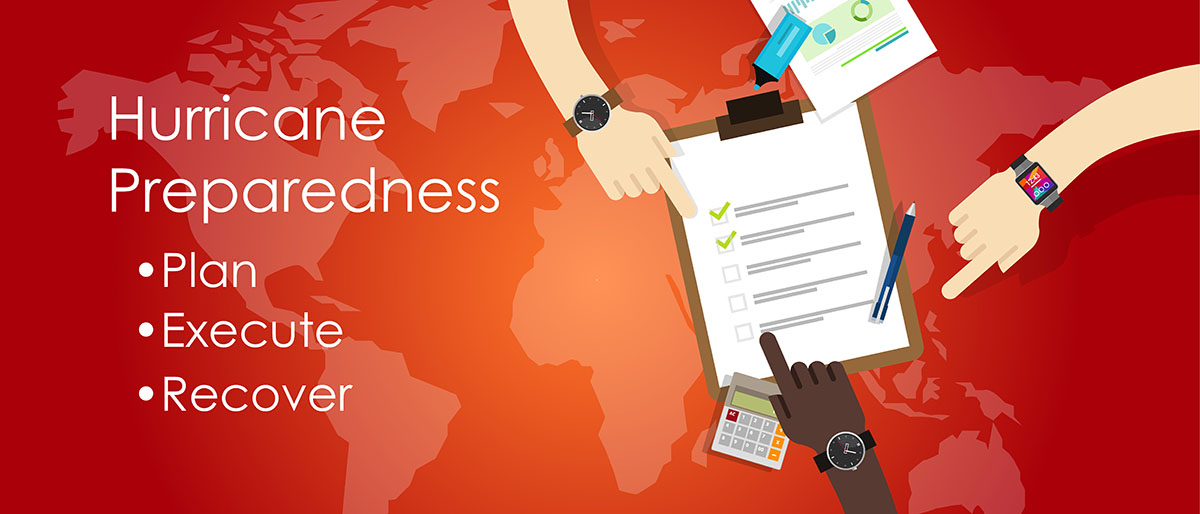With Hurricane Dorian expected to make landfall on Florida’s Atlantic coast late Monday/early Tuesday, many Floridians are preparing to buy supplies and review their evacuation plans.
What should businesses do to prepare?
Being prepared will not only save you time and money but could also save your business.
From initial planning and crisis management to preparing employees and protecting your infrastructure, we outline how you can prepare your business before a major storm hits.
Have a Comprehensive Plan in Place
The Occupational Safety and Health Administration (OSHA) requires most companies to create an Emergency Action Plan, so you can easily incorporate your Hurricane Preparedness Plan into it.
At a minimum, your Hurricane Preparedness Plan should include:
- Circumstances that will activate the plan
- Policies and procedures that address employee safety during a hurricane
- Business continuity and contingency plans if your facilities are damaged
- Protocol for addressing employees, customers and vendors
Crisis management is a critical component of your Hurricane Preparedness Plan.
Prepare Employees
Share your Hurricane Preparedness Plan with your employees. Determine who will be required to be on-site immediately after the hurricane (or even leading up to it), as well as those who are indispensable to the business function, even if they are not needed on-site.
Pro Tip: Conducting a mock hurricane scenario is a great way to ensure employees understand their role in your Hurricane Preparedness Plan.
Finally, share this emergency kit checklist with your employees so they can prepare themselves and their families for the coming storm. Additional hurricane safety tips and resources from the National Weather Service can be found here.
Protect Your Business
The purpose of a Hurricane Preparedness Plan is to:
- Lessen the risk of disruption to business operations
- Ensure a high level of security
- Establish reliable backup systems
Meet with your IT team to ensure that all your documents and equipment are protected and backed up.
Document Everything
Although your IT team likely has a system in place to back up all documentation, you want to make this a priority before addressing anything else.
In addition to digital backups, it’s a good idea to have hard copies to safeguard yourself. If your office is flooded or damaged, hard copies that are stored off-site can ensure that you have some form of documentation you can access. Additional storage precautions should be considered for compliance-regulated data.
Establish Power Backups
If you are forced to operate during a storm, you want to make sure that you have uninterruptible power supplies, such as a generator or battery backup, connected to your vital electronic devices. These power supplies can help protect against surges, and if you do lose power, they can provide time to save and close any important programs.
Many networking devices and servers are designed to reboot or power back on in the event of a power outage. If there is water present when this occurs, it will cause a serious short in the electricity. Best practices dictate that you power down these devices manually to bypass the restart feature in advance of a serious power outage.
Create File and Server Backups
As mentioned, you want to digitally backup your documents and files, but it is also a good idea to back them up via a cloud storage service. Even if your server is off-site, it should be in a location that will not be affected by the same hurricane.
Protect Equipment
Flooding is often the worst effect of a hurricane, so if you are in a location that is prone to flooding or on the first floor, make sure your computers and electronic equipment are stored at least a few feet off the ground.
It is also a good idea to cover items with waterproof tarps and coverings to ensure that leaks do not damage your equipment. Finally, if high winds could affect your office, move equipment away from windows to lessen the chance of being damaged by rain or debris, should the windows break.
If it is not possible to relocate certain elements of your IT infrastructure, such as servers, networking devices, large printers, etc., you can reduce the chance of damage from water and debris by covering windows that are located close to these items. When possible, anchor your equipment, such as rack mounted hardware, to provide protection from wind.
Recovery
Hurricanes often cost billions of dollars’ worth of damage. In the event that your business suffers a loss as a result of a hurricane, you may face serious hurdles in returning to business as usual. Here are five tips for how you can recover:
- Assess damage and consider if a backup location is needed.
- Shift your team and leadership from preparedness to recovery.
- Document damage, file insurance claims and track recovery.
- Provide employee support and assistance.
- Connect with chambers of commerce, economic development and other community support organizations.
Review
Once business operations have returned to normal, take time to conduct a debrief of the execution of your Hurricane Preparedness Plan. You can identify what worked and what didn’t, and update your plan so you’re better prepared for the next storm. Often, it’s not a case of if a major storm will occur but when.
About CIO Tech
Founded in 2010, CIO Technology Solutions, Inc., was established to provide affordable, worry-free IT support to clients, so their focus could be on their business—not their IT needs.
CIO Tech strives to become the trusted technology solutions partner for businesses in need of IT managed services. Our clients come to us because they need a technology solutions partner they can trust.

